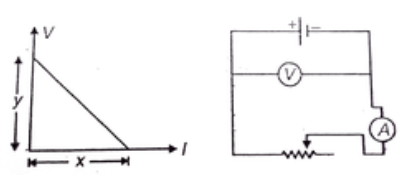What is internal resistance of a cell? Establish a relationship between e.m.f., thermal potential difference and 'r'.
The internal resistance is defined as, "the resistance offered by the electrolyte and electrodes of the cell, when electric current flows through it."
It is denoted by r. Consider a cell of e.m.f E and internal resistance r connected to an external resistance R through a key K as shown in the figure. A voltmeter V is connected across the two electrodes of the cell.
When the key is open, no current flows through the circuit and the reading of the voltmeter is equal to the e.m.f (E) of the cell.
When the key is closed, the current flows through the circuit as shown in the figure. Now, the reading of the voltmeter is equal to terminal potential difference (V) of the cell.
We can write
E−V=Ir⇒r=E−VI .......(i)
But from Ohm.s law, I=VR
Substituting the value of I in equation (i), we get
r=E−VVR
⇒r=(E−V)VR=(EV−1)R

Similar Questions
Establish a relation between E.M.F. and potential difference of a cell.
View SolutionFor the determination of emf E and internal resistance 'r' of a cell , the graph is obtained between potential difference V between the terminal of the cell against the current l, which was changed by adjusting the rheostat, is as shown . The internal resistance of the cell is

View Solution
Knowledge Check
In potentiometer experiment, if l1 is the balancing length for e.m.f. of the cell of internal resistance r and l2 is the balancing length for its terminal potential difference when shunted with resistance R then :
Al1=l2(R+RR)Bl1=l2(RR−r)Cl1=l2(RR+r)Dl1=l2(R−rR)In potentiometer experiment, if l1 is the balancing length for e.m.f. of the cell of internal resistance r and l2 is the balancing length for its terminal potential difference when shunted with resistance R then :
Al1=l2(R+rR)Bl1=l2(RR+r)Cl1=l2(RR−r)Dl1=l2(R−rR)The e.m.f. of a cell is 2.0 volt and the internal resistance is 0.1ohm. It is connected with a resistance of 3.9ohm. Then potential difference across the cell is :–
A0.20VB1.90 VC1.95 VD2.00 V
A cell of emf E and internal resistance r is connected in series with an external resistance nr. Than what will be the ratio of the terminal potential difference to emf, if n=9.
View SolutionA cell of emf E and internal resistance r is connected in series with an external resistance nr. Than what will be the ratio of the terminal potential difference to emf, if n=9.
View SolutionA cell of e.mf. E and internal resistance r is connected in series with an external resistance nr. Then, the ratio of the terminal potential difference to E.M.F.is
View SolutionA cell of e.m.f E and internal resitance r ,is connected to an external resistance R. the variation of potential difference V across the resistance R as function of R as shown in the figure, is the best represented by curve
_PHY_E01_011_Q01.png)
View SolutionA cell of e.mf. E and internal resistance r is connected in series with an external resistance nr. Then, the ratio of the terminal potential difference to E.M.F.is
View Solution
